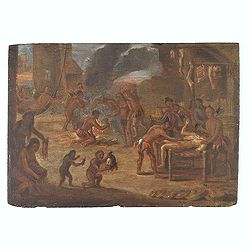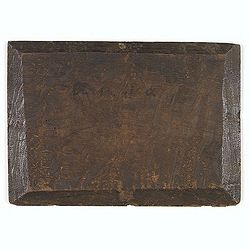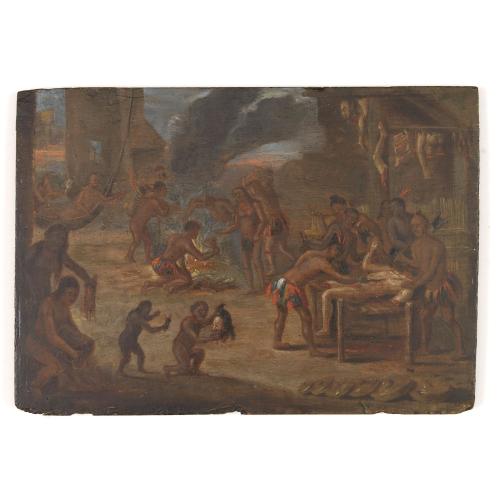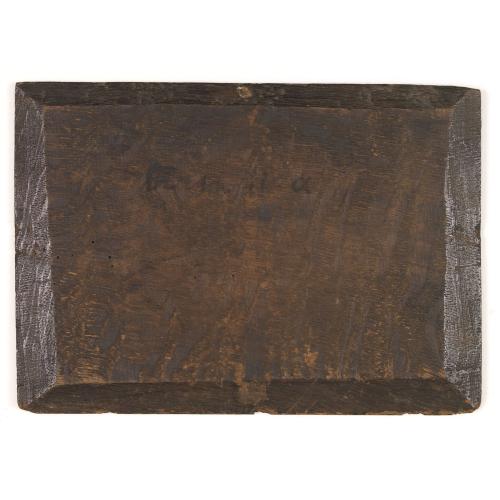Please login to see price!.
Subscribe to be notified if similar examples become available.
Painting of Tupinamba cannibals of Brazil set in a local landscape on wooden panel. |
||||||||||||||||||||
|
||||||||||||||||||||
|
|
||||||||||||||||||||
|
|
||||||||||||||||||||
Description
The iconography of this painting is derived from one of the plates illustrated in the third volume of "Grands Voyages" by Th. Bry taht was devoted to Brazil (Navigatio Brasiliam Americae ) and published in Frankfurt in 1592.The oak panel has on verso the title "America". The oak panel is beveled down at the back along all four sides to a thickness of a few millimeters at the edges, probably to allow the panel to be fixed into the shallow rabbet of a frame later. Practically all seventeenth-century Dutch panels correspond to this description.
The iconography of this painting and another well-known painting by Jan van Kessel II are directly derived from one of the plates in the "Grands Voyages" by Theodore Bry published in 1592. The title of the engraving : "How the Slave Who Had Spoken Ill of Me Was Eaten Himself" was actually based on a woodcut from a 1557 book on Brazil by Hans Staden.
Van Staden was an adventurer from Hesse who had twice traveled to Brazil, where he spent nine months as a prisoner of the Tupinamba cannibals.
In the 17th century paintings of curio cabinets and paintings of Dutch, Colonial interest seemed to be very much in demand. Brazil played an important role and painters such as Albert Eckhout (1637–1664) and Frans Post (1612-ca.1680), as well as naturalists such as Zacharias Wagner (1614–1668), who documented Brazil's flora and fauna, visualized the exotic county and produces.
Cabinets of curiosities seemed to be very popular in the 17th century and these cabinets were filled with preserved animals, horns, tusks, skeletons, minerals, as well as other types of equally fascinating man-made objects, ethnographic specimens from exotic locations. Often they would contain a mix of fact and fiction, including apparently mythical creatures.
Dutch and Flemish painter's like Jan van Kessel I (Antwerpen 1626 - Antwerpen 17-apr-1679) also painted curio cabinets. Van Kessel I was a grandson of Jan Brueghel the Elder through his mother Pachasie.
He worked in Antwerp and several of his thirteen children were also painters, among Jan Van Kessel II and Jan van Kessel III (1654-1708) . Together with Erasmus Quellinus (1607-1678) van Kessel I painted four Allegories of Continents in the form of wonder chambers. The four paintings give an intercultural, ethnographic comparison of the four continents that were known at the time.
A painting by Jan van Kessel shows the same scene of cannibals as our painting but set in a prison environment in the same format as is known. Van Kessel's paintings frequently exhibited a fascination with the bizarre, the exotic, and even the grotesque, as in his Cannibalistic Indians.
Recently, a painting with the text America on the verso was auctioned with Hargesheimer & Günther, Düsseldorf in Germany.
This painting belonged to a larger series of works on copper plate, which symbolize the four continents and were painted by Jan van Kessel in the 1660's. They come from the royal collection of Charles IV of Spain and 40 panels are now in the Prado Museum (see also exhibit Brussels, Palais des Beaux-Arts, 1980), two more tables in a private collection in Paris.
A second, complete series of the same theme today preserved in the Alte Pinakothek Munich. It consists of 4 big and 64 small tables, a variant of which included painting.
Cannibalism.
The European interest in cannibalism was little short of an obsession. It became a favorite theme in Renaissance art almost overnight, and was additionally a fundamental aspect of nearly every sixteenth-century tract dealing with the New World.
French travelers of the mid-16th century who tried, at the instigation of Admiral Coligny, set on an island in the current bay of Rio de Janeiro, a colony of "Antarctic France", were indeed confused by cannibalistic habits of the natives.
Some tribes ate their enemies killed in battle so they thought, to appropriate force. The prisoners were in turn incorporated into the tribe where they were cared for and fed until they were to be consumed. They were then fatally knocked down, their bodies cut into pieces and cooked by women in earthen pots with water and corn.
It is much less certain that the members were grilled on the fire like game, where the pin runs including a leg man is probably an invention of European artists who exploited the taste of the thrill and horror without attributed to these savages as any related real brutality.
Still, the De Bry illustrations of cannibalism achieved canonical status, based on the account of Hans Staden, the adventurer from Hesse who had twice traveled to Brazil, where he spent nine months as prisoner of the Tupinamba cannibals of Brazil. His clearly authentic account was illustrated by crude but informative woodcuts made under his supervision. Although eating human flesh, according to theories of the similarity of food, could be seen as nutritionally perfect, it was by no means to be tolerated, and no early modern reader needed advice on how to interpret the practice of eating human flesh.
Bibliography:
Thierry Lefrancois, New World Museum. Manual visitor and amateur, La Rochelle, 1990.
Thierry Lefrancois, The Allegory of America through the collections of the Musée du Nouveau Monde, La Revue du Louvre Museums of France, 1992.
Par Benjamin J. Kaplan, Mary Beth Carlson, Laura Cruz, Boundaries and Their Meanings in the History of the Netherlands.
The oak panel has on verso the title "America". The oak panel is beveled down at the back along all four sides to a thickness of a few millimeters at the edges, probably to allow the panel to be fixed into the shallow rabbet of a frame later. Practically all seventeenth-century Dutch panels correspond to this description.
The iconography of this painting and another well-known painting by Jan van Kessel II are directly derived from one of the plates in the "Grands Voyages" by Theodore Bry published in 1592. The title of the engraving : "How the Slave Who Had Spoken Ill of Me Was Eaten Himself" was actually based on a woodcut from a 1557 book on Brazil by Hans Staden.
Van Staden was an adventurer from Hesse who had twice traveled to Brazil, where he spent nine months as a prisoner of the Tupinamba cannibals.
In the 17th century paintings of curio cabinets and paintings of Dutch, Colonial interest seemed to be very much in demand. Brazil played an important role and painters such as Albert Eckhout (1637–1664) and Frans Post (1612-ca.1680), as well as naturalists such as Zacharias Wagner (1614–1668), who documented Brazil's flora and fauna, visualized the exotic county and produces.
Cabinets of curiosities seemed to be very popular in the 17th century and these cabinets were filled with preserved animals, horns, tusks, skeletons, minerals, as well as other types of equally fascinating man-made objects, ethnographic specimens from exotic locations. Often they would contain a mix of fact and fiction, including apparently mythical creatures.
Dutch and Flemish painter's like Jan van Kessel I (Antwerpen 1626 - Antwerpen 17-apr-1679) also painted curio cabinets. Van Kessel I was a grandson of Jan Brueghel the Elder through his mother Pachasie.
He worked in Antwerp and several of his thirteen children were also painters, among Jan Van Kessel II and Jan van Kessel III (1654-1708) . Together with Erasmus Quellinus (1607-1678) van Kessel I painted four Allegories of Continents in the form of wonder chambers. The four paintings give an intercultural, ethnographic comparison of the four continents that were known at the time.
A painting by Jan van Kessel shows the same scene of cannibals as our painting but set in a prison environment in the same format as is known. Van Kessel's paintings frequently exhibited a fascination with the bizarre, the exotic, and even the grotesque, as in his Cannibalistic Indians.
Recently, a painting with the text America on the verso was auctioned with Hargesheimer & Günther, Düsseldorf in Germany.
This painting belonged to a larger series of works on copper plate, which symbolize the four continents and were painted by Jan van Kessel in the 1660's. They come from the royal collection of Charles IV of Spain and 40 panels are now in the Prado Museum (see also exhibit Brussels, Palais des Beaux-Arts, 1980), two more tables in a private collection in Paris.
A second, complete series of the same theme today preserved in the Alte Pinakothek Munich. It consists of 4 big and 64 small tables, a variant of which included painting.
Cannibalism.
The European interest in cannibalism was little short of an obsession. It became a favorite theme in Renaissance art almost overnight, and was additionally a fundamental aspect of nearly every sixteenth-century tract dealing with the New World.
French travelers of the mid-16th century who tried, at the instigation of Admiral Coligny, set on an island in the current bay of Rio de Janeiro, a colony of "Antarctic France", were indeed confused by cannibalistic habits of the natives.
Some tribes ate their enemies killed in battle so they thought, to appropriate force. The prisoners were in turn incorporated into the tribe where they were cared for and fed until they were to be consumed. They were then fatally knocked down, their bodies cut into pieces and cooked by women in earthen pots with water and corn.
It is much less certain that the members were grilled on the fire like game, where the pin runs including a leg man is probably an invention of European artists who exploited the taste of the thrill and horror without attributed to these savages as any related real brutality.
Still, the De Bry illustrations of cannibalism achieved canonical status, based on the account of Hans Staden, the adventurer from Hesse who had twice traveled to Brazil, where he spent nine months as prisoner of the Tupinamba cannibals of Brazil. His clearly authentic account was illustrated by crude but informative woodcuts made under his supervision. Although eating human flesh, according to theories of the similarity of food, could be seen as nutritionally perfect, it was by no means to be tolerated, and no early modern reader needed advice on how to interpret the practice of eating human flesh.
Bibliography:
Thierry Lefrancois, New World Museum. Manual visitor and amateur, La Rochelle, 1990.
Thierry Lefrancois, The Allegory of America through the collections of the Musée du Nouveau Monde, La Revue du Louvre Museums of France, 1992.
Par Benjamin J. Kaplan, Mary Beth Carlson, Laura Cruz, Boundaries and Their Meanings in the History of the Netherlands.
FAQ - Guarantee - Shipping
Buying in the BuyNow Gallery
This item is available for immediate purchase when a "Add to Cart" or "Inquire Now" button is shown.
Items are sold in the EU margin scheme
Payments are accepted in Euros or US Dollars.
Authenticity Guarantee
 We provide professional descriptions, condition report (based on 45 years experience in the map business)
We provide professional descriptions, condition report (based on 45 years experience in the map business)
Paulus Swaen warrants the authenticity of our items and a certificate of authenticity is provided for each acquired lot.
Condition and Coloring
We indicate the condition of each item and use our unnique HiBCoR grading system in which four key items determine a map's value: Historical Importance, Beauty, Condition/Coloring and Rarity.
Color Key
We offer many maps in their original black and white condition. We do not systematically color-up maps to make them more sellable to the general public or buyer.
Copper engraved or wood block maps are always hand colored. Maps were initially colored for aesthetic reasons and to improve readability. Nowadays, it is becoming a challenge to find maps in their original colors and are therefor more valuable.
We use the following color keys in our catalog:
Original colors; mean that the colors have been applied around the time the map was issued.
Original o/l colors; means the map has only the borders colored at the time of publication.
Colored; If the colors are applied recently or at the end of the 20th century.
Read more about coloring of maps [+]
Shipping fee
A flat shipping fee of $ 30 is added to each shipment by DHL within Europe and North America. This covers : International Priority shipping, Packing and Insurance (up to the invoice amount).
Shipments to Asia are $ 40 and rest of the world $50
We charge only one shipping fee when you have been successful on multiple items or when you want to combine gallery and auction purchases.
Read more about invoicing and shipping
FAQ
Please have a look for more information about buying in the BuyNow gallery
Many answers are likely to find in the general help section.
Virtual Collection
![]()
With Virtual Collection you can collect all your favorite items in one place. It is free, and anyone can create his or her Virtual map collection.
Unless you are logged in, the item is only saved for this session. You have to be registed and logged-in if you want to save this item permanently to your Virtual Collection.
Read More[+]
Register here, it is free and you do not need a credit card.
Add this item to
Virtual Collection
or click the following link to see my Virtual Collection.
| Digital Image Download | |
|
Paulus Swaen maintains an archive of most of our high-resolution rare maps, prints, posters and medieval manuscript scans. We make them freely available for download and study. Read more about free image download |
In accordance with the EU Consumer Rights Directive and habitually reside in the European Union you have the right to cancel the contract for the purchase of a lot, without giving any reason.
The cancellation period will expire 14 calendar days from the day after the date on which you or a third party (other than the carrier and indicated by you) acquires, physical possession of the lot. To exercise the right to cancel you must inform Paulus Swaen Inc, of your decision to cancel this contract by a clear statement (e.g. a letter sent by post, or e-mail (amsterdam@swaen.com).
To meet the cancellation deadline, it is sufficient for you to send your communication concerning your exercise of the right to cancel before the cancellation period has expired.



